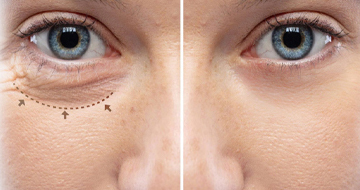Eyelid surgery, or blepharoplasty, is a sought-after cosmetic procedure aimed at enhancing the appearance of the eyes by addressing issues like sagging skin, puffiness, and under-eye bags. This surgery can also improve functionality by addressing conditions that affect vision. In this guide, we’ll delve into what blepharoplasty involves, the different types of procedures, and what to expect before, during, and after surgery.
What is Blepharoplasty?
Blepharoplasty is a surgical procedure focused on reshaping the eyelids to achieve a more youthful and refreshed appearance. It can address several concerns, including:
- Excess Skin: Removing sagging skin from the upper eyelids that may obstruct vision or create a tired appearance.
- Puffiness: Eliminating fat deposits and puffiness from the lower eyelids to create a smoother look.
- Asymmetry: Correcting unevenness or asymmetry between the eyelids.
- Functional Improvement: Enhancing vision if sagging eyelids are impeding your field of view.
Types of Blepharoplasty Procedures
There are various approaches to blepharoplasty, each tailored to different needs and goals:
-
Upper Eyelid Blepharoplasty
Focuses on removing excess skin and fat from the upper eyelids. Often performed to improve vision obstructed by drooping lids and to create a more youthful appearance.
-
Lower Eyelid Blepharoplasty
Addresses puffiness and bags under the eyes by removing or repositioning fat. Can also involve tightening loose skin to improve the overall contour of the lower eyelids.
-
Transconjunctival Blepharoplasty
Involves making incisions inside the lower eyelid, leaving no visible scars. Ideal for younger patients or those with less excess skin, primarily addressing fat deposits.
-
Revision Blepharoplasty
Performed to correct or refine results from a previous eyelid surgery. Can address issues such as residual puffiness or asymmetry that persists after the initial surgery.
The Blepharoplasty Procedure
The process of blepharoplasty involves several key stages:
-
Consultation
The initial consultation with a board-certified plastic surgeon is crucial. During this visit, you’ll discuss your goals, review your medical history, and evaluate the condition of your eyelids. The surgeon will take photographs and recommend a personalized surgical plan.
-
Pre-Surgery Preparation
You will receive specific instructions on how to prepare for the surgery, including dietary restrictions and medication guidelines. You may need to undergo a medical evaluation to ensure you are fit for surgery.
-
Anesthesia
Blepharoplasty is typically performed under local anesthesia with sedation or general anesthesia, depending on the extent of the procedure and your comfort.
-
Incision and Reshaping
The surgeon will make precise incisions based on the type of blepharoplasty being performed:
- For upper eyelid surgery, incisions are made along the natural creases of the eyelids.
- For lower eyelid surgery, incisions may be made either just below the lash line or inside the eyelid. The excess skin, fat, and sometimes muscle are carefully removed or repositioned to achieve the desired look.
-
Closing the Incisions
The incisions are closed with sutures, and a bandage or surgical tape may be applied to support the healing process.
Recovery and Aftercare
-
Initial Recovery
After the surgery, you’ll be monitored in a recovery area. You may experience swelling, bruising, and discomfort, which can be managed with prescribed medications and cold compresses. Your eyes may feel tight or dry initially, but these sensations usually subside within a few days.
-
Follow-Up Appointments
Regular follow-up appointments with your surgeon are essential to monitor healing and address any concerns. These visits help ensure that the incisions are healing properly and that you’re on track for a smooth recovery.
-
Long-Term Care
Avoid strenuous activities and heavy lifting for a few weeks. Your surgeon will provide guidance on when you can resume normal activities, including exercise and wearing makeup. Full recovery can take several weeks, with final results becoming apparent after a few months as swelling continues to subside.
Benefits of Blepharoplasty
- Enhanced Appearance: Creates a more youthful and refreshed look by removing excess skin and fat.
- Improved Vision: Can restore a clear field of vision if sagging eyelids were obstructing your view.
- Boosted Confidence: Many people experience increased self-esteem and satisfaction with their appearance.
- Customized Results: The procedure can be tailored to meet your specific aesthetic and functional needs.
Risks and Considerations
As with any surgical procedure, blepharoplasty carries some risks, including:
- Infection
- Scarring
- Dry Eyes or Irritation
- Asymmetry or Dissatisfaction with Results
Choosing a skilled and experienced surgeon is crucial to minimizing these risks and achieving the best possible outcome.


